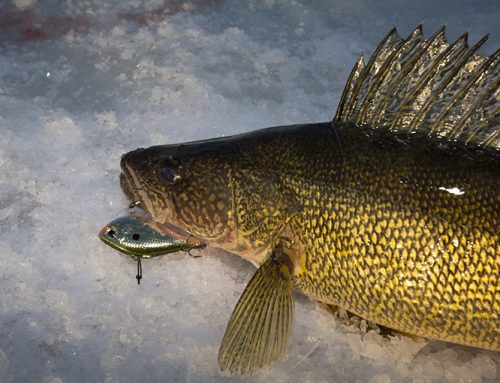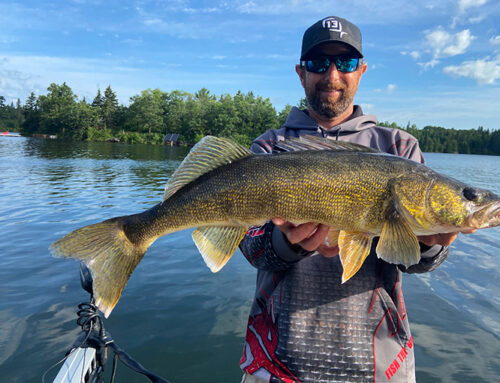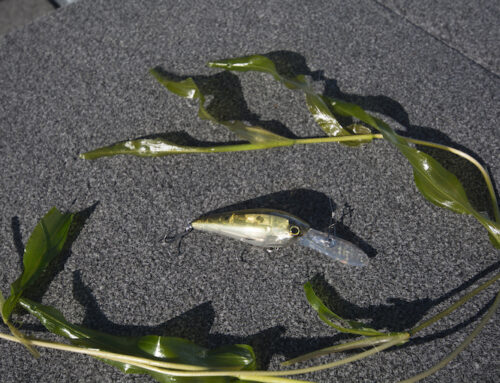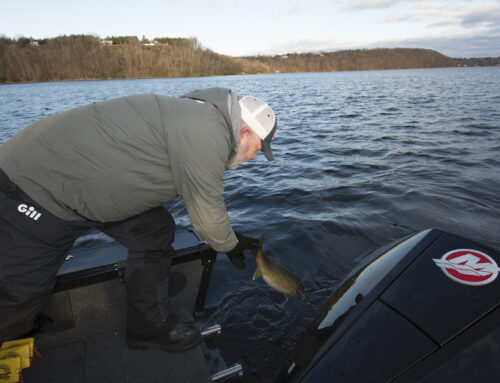
Most outdoor writers adhere to the red-cap school of photography that teaches, “someone posing with a fish will always look better if they’re wearing something colourful.” As you might expect, red caps look great, as do funky-looking rainsuits. My friend, Richard Brochu, has it half right. He likes yellow rain jackets and blaze-orange hats, but one of his jackets is two sizes too small and ripped down the centre. In my photos of him, he looks like the Incredible Hulk halfway through transformation. Normally, I’d chew up a friend over such a serious fashion faux pas, but I don’t because I owe him a favour. He turned me on to fishing walleye in the pads.
Walleye, jumbo perch, and pike
“We catch walleye in the pads most of the summer,” Richard had mentioned to me over breakfast one August morning two years ago. “The fish are feeding on perch and bugs. We catch some big jumbo perch in the pads, and a few pike, but mostly walleye. Lots of them.” I was skeptical. In 30 or so years of angling, I’d never caught a walleye anywhere near lily pads, so I asked him to show me the ropes.
The lake we fished was typical of the Canadian Shield. It could have been any one of thousands of average walleye lakes anywhere in Ontario. Richard wanted to fish a pad bed within a small maze of islands. The lake was relatively shallow – averaging about 10 feet (3 m), with a few holes that reached 30 feet (9 m) – and the bottom came up quickly around the islands. However, I noticed there was a 5-foot-deep (1.5 m) channel between the islands that connected deep water to shallow. Most of the slot was bordered by lily pads the size of Frisbees. As we approached frog heaven, I killed the big motor and dropped the front electric.
Toss jigs for walleye
“I usually just work around the pads and toss jigs,” said Richard. “The fish can be anywhere.”

He tied on a jig and a yellow plastic twister-tail grub, and impaled a leech on the hook. His presentation was basic. He’d pitch the jig into a gap between pads and reel it back with only a slight swimming movement. His first fish was a 12-inch (30.5 cm) perch. My fashion defying partner threw it in the livewell and was soon back at it.
Up front, I was tossing a light jig and a grub into the deeper channel off the edge of the pads and retrieving with a drag and a sharp hop – a kinder, gentler version of rip-jigging. I soon hooked a 2-pound (.9 kg) walleye, as yellow as sweet corn and warm to the touch. It was the first of several Richard and I would catch in this area. Some of the fish were right under shallow pads, others were just off the deep edge. None were in water deeper than 6 feet (1.8 m).
I shouldn’t have been surprised that walleye like pads. Whether they’re actually sensitive to bright light is debatable, but there’s no doubt walleye prefer to feed in dim conditions and in the seclusion of overhead cover. Lily pads fill the bill and are home to a variety of insects and smaller fish for walleye to feed on.
Fish the pads during peaks
There are peak periods to hit the pads for walleye. Windy days are good. Waves disorient baitfish, stir up insects, and disperse sunlight. They open the door for walleye to cruise the shallows. Clouds and rain don’t hurt the fishing either.
The best pad beds for walleye will be near deeper water. This might be only a 6-foot-deep channel near a 2-foot-deep (.6 m) flat, but it will be enough to provide sanctuary for walleye if they feel threatened. Give the deep edges of pads a serious workout before you fight your way into the middle of them. Edge walleye are easier to hook and land than those right in cover. In cahn, sunny conditions, walleye will more likely be on the deep edge. If you get no takers there, look for holes and pockets between pads where you can work a jig with the least amount of hassle.
Watch your line
Keep the jig moving and pop it sharply with your rod tip whenever you feel a hesitation. Watch your line. Walleye can inhale and exhale a jig in a split-second, and any twitch or tightening of the line should be answered with a strike.
Standard 1/4-ounce ball-head or banana-head jigs are fine for fishing pad walleye. If the pads are thick or mixed with other vegetation, a weedless jig is more appropriate. Bait can be added as sweetener, but is seldom necessary. Shallow-water walleye pounce on anything that looks like food. Pad stems are tough, so expect to lose a few jigs. Shallow walleye are not line-shy, so you can use bass tackle. I use a 6-foot medium-action spinning rod and a reel loaded with 10-pound-test line.
Check the pads for walleye in your favourite lakes this summer, but do me a favour. If you have an outdoor writer in the boat, lose the ripped rainsuit.
Originally published in the July 1999 issue of Ontario OUT of DOORS magazine






Leave A Comment